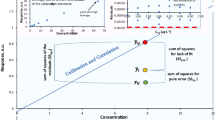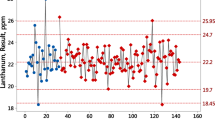Abstract
In scientific research laboratories it is rarely possible to use quality assurance schemes, developed for large-scale analysis. Instead methods have been developed to control the quality of modest numbers of analytical results by relying on statistical control:
Analysis of precision serves to detect analytical errors by comparing thea priori precision of the analytical results with the actual variability observed among replicates or duplicates. The method relies on the chi-square distribution to detect excess variability and is quite sensitive even for 5–10 results.
Interference control serves to detect analytical bias by comparing results obtained by two different analytical methods, each relying on a different detection principle and therefore exhibiting different influence from matrix elements; only 5–10 sets of results are required to establish whether a regression line passes through the origo.
Calibration control is an essential link in the traceability of results. Only one or two samples of pure solid or aqueous standards with accurately known content need to be analyzed.
Verification is carried out by analyzing certified reference materials from BCR, NIST, or others; their limited accuracy of 5–10% make them less suitable for calibration purposes.
Similar content being viewed by others
References
K. Heydorn,Neutron Activation Analysis in Clinical Trace Element Research, Vols. 1, 2, CRC Press, Boca Raton, 1984.
K. Heydorn, E. Damsgaard,J. Radioanal. Nucl. Chem. 1987,110, 539.
C. O. Ingamells, P. Switzer,Talanta 1973,20, 547.
E. Schnug, S. Haneklaus, Personal communication, 1990.
S. Bro, B. Sandström, K. Heydorn,J. Trace Elem. Electrolytes Health Dis. 1990,4, 147.
K. Heydorn,Aspects of Precision and Accuracy in Neutron Activation Analysis, Risø, Roskilde, 1980, pp. 180–182.
J. R. Moody, R. R. Greenberg, K. W. Pratt, T. C. Rains,Anal. Chem. 1988,60, 1203A.
BCR Reference Materials, Community Bureau of Reference, Brussels, 1990.
E. Cortes Toro, R. M. Parr, S. A. Clements,IAEA/RL/128, International Atomic Energy Agency, Vienna, 1990.
National Institute for Standards and Technology, NIST Special Publication 260, Standard Reference Materials Catalog, 1990–91.
J. K. Taylor,Anal. Chem. 1983,55, 600A.
ISO Guide 31, Geneva, 1981.
P. Giacomo,Metrologia 1981,17, 73.
J. M. Christensen, Personal communication, 1990.
L. H. Christensen, K. Heydorn,Nucl. Instrum. Method 1990,A299, 562.
Author information
Authors and Affiliations
Rights and permissions
About this article
Cite this article
Heydorn, K. Quality assurance and statistical control. Mikrochim Acta 105, 1–10 (1991). https://doi.org/10.1007/BF01245194
Received:
Issue Date:
DOI: https://doi.org/10.1007/BF01245194




